Tesamorelin
Editor-In-Chief: C. Michael Gibson, M.S., M.D. [1]; Associate Editor(s)-in-Chief: Kiran Singh, M.D. [2]
Disclaimer
WikiDoc MAKES NO GUARANTEE OF VALIDITY. WikiDoc is not a professional health care provider, nor is it a suitable replacement for a licensed healthcare provider. WikiDoc is intended to be an educational tool, not a tool for any form of healthcare delivery. The educational content on WikiDoc drug pages is based upon the FDA package insert, National Library of Medicine content and practice guidelines / consensus statements. WikiDoc does not promote the administration of any medication or device that is not consistent with its labeling. Please read our full disclaimer here.
Overview
Tesamorelin is a Growth hormone secretagogues that is FDA approved for the treatment of reduction of excess abdominal fat in HIV-infected patients with lipodystrophy. Common adverse reactions include arthralgia, injection site erythema, injection site pruritis, pain in extremity, peripheral edema, myalgia..
Adult Indications and Dosage
FDA-Labeled Indications and Dosage (Adult)
Indications
- Tesamorelin® (tesamorelin for injection) is indicated for the reduction of excess abdominal fat in HIV-infected patients with lipodystrophy.
Limitations of Use:
- Since the long-term cardiovascular safety and potential long-term cardiovascular benefit of tesamorelin treatment have not been studied and are not known, careful consideration should be given whether to continue tesamorelin treatment in patients who do not show a clear efficacy response as judged by the degree of reduction in visceral adipose tissue measured by waist circumference or CT scan.
- Tesamorelin is not indicated for weight loss management (weight neutral effect).
- There are no data to support improved compliance with anti-retroviral therapies in HIV-positive patients taking tesamorelin.
Dosage
General Dosing Information
- The recommended dose of tesamorelin is 2 mg injected subcutaneously once a day.
- The recommended injection site is the abdomen. Injection sites should be rotated to different areas of the abdomen. Do not inject into scar tissue, bruises or the navel.
DOSAGE FORMS AND STRENGTHS
- Tesamorelin (tesamorelin for injection) is supplied in a vial containing 2 mg of tesamorelin as a lyophilized powder. The diluent (Sterile Water for Injection, USP 10 mL) is provided in a separate bottle.
Off-Label Use and Dosage (Adult)
Guideline-Supported Use
There is limited information regarding Off-Label Guideline-Supported Use of Tesamorelin in adult patients.
Non–Guideline-Supported Use
There is limited information regarding Off-Label Non–Guideline-Supported Use of Tesamorelin in adult patients.
Pediatric Indications and Dosage
FDA-Labeled Indications and Dosage (Pediatric)
There is limited information regarding FDA-Labeled Use of Tesamorelin in pediatric patients.
Off-Label Use and Dosage (Pediatric)
Guideline-Supported Use
There is limited information regarding Off-Label Guideline-Supported Use of Tesamorelin in pediatric patients.
Non–Guideline-Supported Use
There is limited information regarding Off-Label Non–Guideline-Supported Use of Tesamorelin in pediatric patients.
Contraindications
Disruption of the Hypothalamic-pituitary Axis
- Tesamorelin is contraindicated in patients with disruption of the hypothalamic-pituitary axis due to hypophysectomy, hypopituitarism, pituitary tumor/surgery, head irradiation or head trauma.
Active Malignancy
- Tesamorelin is contraindicated in patients with active malignancy (either newly diagnosed or recurrent). Any preexisting malignancy should be inactive and its treatment complete prior to instituting therapy with tesamorelin.
Hypersensitivity
- Tesamorelin is contraindicated in patients with known hypersensitivity to tesamorelin and/or mannitol (an excipient).
Pregnancy
- Tesamorelin is contraindicated in pregnant women. During pregnancy, visceral adipose tissue increases due to normal metabolic and hormonal changes. Modifying this physiologic change of pregnancy with tesamorelin offers no known benefit and could result in fetal harm. Tesamorelin acetate administration to rats during organogenesis and lactation resulted in hydrocephalus in offspring at a dose approximately two and four times the clinical dose, respectively, based on measured drug exposure (AUC). If pregnancy occurs, discontinue tesamorelin therapy. If this drug is used during pregnancy, or if the patient becomes pregnant while taking this drug, the patient should be apprised of the potential hazard to the fetus
Warnings
Neoplasms
- Tesamorelin induces the release of endogenous growth hormone (GH), a known growth factor. Thus, patients with active malignancy should not be treated with tesamorelin.
- For patients with a history of non-malignant neoplasms, tesamorelin therapy should be initiated after careful evaluation of the potential benefit of treatment. For patients with a history of treated and stable malignancies, tesamorelin therapy should be initiated only after careful evaluation of the potential benefit of treatment relative to the risk of re-activation of the underlying malignancy.
- In addition, the decision to start treatment with tesamorelin should be considered carefully based on the increased background risk of malignancies in HIV-positive patients.
Elevated IGF-1
- Tesamorelin stimulates GH production and increases serum IGF-1. Given that IGF-1 is a growth factor and the effect of prolonged elevations in IGF-1 levels on the development or progression of malignancies is unknown, IGF-1 levels should be monitored closely during tesamorelin therapy. Careful consideration should be given to discontinuing tesamorelin in patients with persistent elevations of IGF-1 levels (e.g., >3 SDS), particularly if the efficacy response is not robust (e.g., based on visceral adipose tissue changes measured by waist circumference or CT scan).
- During the clinical trials, patients were monitored every three months. Among patients who received tesamorelin for 26 weeks, 47.4% had IGF-1 levels greater than 2 standard deviation scores (SDS), and 35.6% had SDS >3, with this effect seen as early as 13 weeks of treatment. Among those patients who remained on tesamorelin for a total of 52 weeks, at the end of treatment 33.7% had IGF-1 SDS >2 and 22.6% had IGF-1 SDS >3.
Fluid Retention
- Fluid retention may occur during tesamorelin therapy and is thought to be related to the induction of GH secretion. It manifests as increased tissue turgor and musculoskeletal discomfort resulting in a variety of adverse reactions (e.g. edema, arthralgia, carpal tunnel syndrome) which are either transient or resolve with discontinuation of treatment.
Glucose Intolerance
- Tesamorelin treatment may result in glucose intolerance. During the Phase 3 clinical trials, the percentages of patients with elevated HbA1c (≥ 6.5%) from baseline to Week 26 were 4.5% and 1.3% in the tesamorelin and placebo groups, respectively. An increased risk of developing diabetes with tesamorelin (HbA1c level ≥ 6.5%) relative to placebo was observed [intent-to-treat hazard odds ratio of 3.3 (CI 1.4, 9.6)]. Therefore, glucose status should be carefully evaluated prior to initiating tesamorelin treatment. In addition, all patients treated with tesamorelin should be monitored periodically for changes in glucose metabolism to diagnose those who develop impaired glucose tolerance or diabetes. Diabetes is a known cardiovascular risk factor and patients who develop glucose intolerance have an elevated risk for developing diabetes. Caution should be exercised in treating HIV-positive patients with lipodystrophy with tesamorelin if they develop glucose intolerance or diabetes, and careful consideration should be given to discontinuing tesamorelin treatment in patients who do not show a clear efficacy response as judged by the degree of reduction in visceral adipose tissue by waist circumference or CT scan measurements.
- Since tesamorelin increases IGF-1, patients with diabetes who are receiving ongoing treatment with tesamorelin should be monitored at regular intervals for potential development or worsening of retinopathy.
Hypersensitivity Reactions
- Hypersensitivity reactions may occur in patients treated with tesamorelin. Hypersensitivity reactions occurred in 3.6% of patients with HIV-associated lipodystrophy treated with tesamorelin in the Phase 3 clinical trials. These reactions included pruritus, erythema, flushing, urticaria, and other rash. In cases of suspected hypersensitivity reactions, patients should be advised to seek prompt medical attention and treatment with tesamorelin should be discontinued immediately.
Injection Site Reactions
- Tesamorelin treatment may cause injection site reactions, including injection site erythema, pruritus, pain, irritation, and bruising. The incidence of injection site reactions was 24.5% in tesamorelin-treated patients and 14.4% in placebo-treated patients during the first 26 weeks of treatment in the Phase 3 clinical trials. For patients who continued tesamorelin® for an additional 26 weeks, the incidence of injection site reactions was 6.1%. In order to reduce the incidence of injection site reactions, it is recommended to rotate the site of injection to different areas of the abdomen.
Acute Critical Illness
- Increased mortality in patients with acute critical illness due to complications following open heart surgery, abdominal surgery or multiple accidental trauma, or those with acute respiratory failure has been reported after treatment with pharmacologic amounts of growth hormone. tesamorelin® has not been studied in patients with acute critical illness. Since tesamorelin® stimulates growth hormone production, careful consideration should be given to discontinuing tesamorelin® in critically ill patients.
Adverse Reactions
Clinical Trials Experience
- The most commonly reported adverse reactions are hypersensitivity (e.g., rash, urticaria) reactions due to the effect of GH (e.g., arthralgia, extremity pain, peripheral edema, hyperglycemia, carpal tunnel syndrome), injection site reactions (injection site erythema, pruritis, pain, urticaria, irritation, swelling, hemorrhage).
- During the first 26 weeks of treatment (main phase), discontinuations as a result of adverse reactions occurred in 9.6% of patients receiving tesamorelin® and 6.8% of patients receiving placebo. Apart from patients with hypersensitivity reactions identified during the studies and who were discontinued per protocol (2.2%), the most common reasons for discontinuation of tesamorelin® treatment were adverse reactions due to the effect of GH (4.2%) and local injection site reactions (4.6%).
- During the following 26 weeks of treatment (extension phase), discontinuations as a result of adverse events occurred in 2.4% of patients in the T-T group (patients treated with tesamorelin for Week 0-26 and with tesamorelin for Week 26-52) and 5.2% of patients in the T-P group (patients treated with tesamorelin for Week 0-26 and with placebo for Week 26-52).
Clinical Trial Experience
- Because clinical trials are conducted under widely varying conditions, adverse reaction rates observed in the clinical trials of a drug cannot be directly compared to rates in the clinical trials of another drug and may not reflect the rates observed in practice.
- Seven hundred and forty HIV-infected patients with lipodystrophy and excess abdominal fat were exposed to tesamorelin® in the Phase 3 clinical trials; of these 543 received tesamorelin® during the initial 26-week placebo-controlled phase.
- Adverse reactions that occurred more frequently with tesamorelin® relative to placebo and had an incidence ≥1% during the first 26 weeks across all studies are presented in Table 1.

- Mean levels of fasting blood glucose and fasting insulin were not significantly different between tesamorelin® -treated and placebo-treated patients after 26 weeks of treatment.
- In the tesamorelin Phase 3 clinical trials, mean baseline (Week 0) HbA1c was 5.26% among patients in the tesamorelin® group and 5.28% among those in the placebo group. At Week 26, mean HbA1c was higher among patients treated with tesamorelin® compared with placebo (5.39% vs. 5.28% for the tesamorelin® and placebo groups, respectively, mean treatment difference of 0.12%, p=0.0004). Patients receiving tesamorelin® had an increased risk of developing diabetes (HbA1c level ≥ 6.5%) compared with placebo (4.5% vs. 1.3%), with a hazard ratio of 3.3 (CI 1.4, 9.6).
- Adverse reactions observed during Week 26 to 52 of the Phase 3 clinical trials which had an incidence of ≥1% and were seen more frequently with tesamorelin® relative to placebo are presented in Table 2:

- For patients who continued from Week 26-52, mean levels of fasting blood glucose, fasting insulin, and HbA1c were not different between the T-T and T-P groups.
Immunogenicity
- As with all therapeutic proteins and peptides, there is a potential for in vivo development of anti- tesamorelin® antibodies. In the combined Phase 3 clinical trials anti-tesamorelin IgG antibodies were detected in 49.5% of patients treated with tesamorelin® for 26 weeks and 47.4% of patients who received tesamorelin® for 52 weeks. In the subset of patients with hypersensitivity reactions, anti-tesamorelin IgG antibodies were detected in 85.2%. Cross-reactivity to endogenous growth hormone-releasing hormone (GHRH) was observed in approximately 60% of patients who developed anti-tesamorelin antibodies. Patients with and without anti-tesamorelin IgG antibodies had similar mean reductions in visceral adipose tissue (VAT) and IGF-1 response suggesting that the presence of antibodies did not alter the efficacy of tesamorelin®. In a group of patients who had antibodies to tesamorelin after 26 weeks of treatment (56%) and were re-assessed 6 months later, after stopping tesamorelin® treatment, 18% were still antibody positive.
- Neutralizing antibodies to tesamorelin and hGHRH were detected in vitro at Week 52 in 10% and 5% of tesamorelin®-treated patients, respectively. They did not appear to have an impact on efficacy, as evidenced by comparable changes in VAT and IGF-1 level in patients with or without in vitro neutralizing antibodies.
- The observed incidence of antibody positivity in an assay is highly dependent on several factors including assay sensitivity and specificity, methodology, sample handling, timing of sample collection, concomitant medication and underlying disease. For these reasons, comparison of the incidence of antibodies to tesamorelin® with the incidence of antibodies to other products may be misleading.
Postmarketing Experience
There is limited information regarding Postmarketing Experience of Tesamorelin in the drug label.
Drug Interactions
Cytochrome P450-Metabolized Drugs
- Co-administration of tesamorelin® with simvastatin, a sensitive CYP3A substrate, showed that tesamorelin® had no significant impact on the pharmacokinetics profiles of simvastatin in healthy subjects. This result suggests that tesamorelin® may not significantly affect CYP3A activity. Other isoenzymes of CYP450 have not been evaluated with tesamorelin®. Published data, however, indicate that GH may modulate cytochrome P450 (CYP450) mediated antipyrine clearance in man. These data suggest that GH may alter the clearance of compounds known to be metabolized by CYP450 liver enzymes (e.g., corticosteroids, sex steroids, anticonvulsants, cyclosporine). Because tesamorelin stimulates GH production, careful monitoring is advisable when tesamorelin® is administered in combination with other drugs known to be metabolized by CYP450 liver enzymes.
11β-Hydroxysteroid Dehydrogenase Type 1 (11βHSD-1)
- GH is known to inhibit 11β-hydroxysteroid dehydrogenase type 1 (11βHSD-1), a microsomal enzyme required for conversion of cortisone to its active metabolite, cortisol, in hepatic and adipose tissue. Because tesamorelin stimulates GH production, patients receiving glucocorticoid replacement for previously diagnosed hypoadrenalism may require an increase in maintenance or stress doses following initiation of tesamorelin®, particularly in patients treated with cortisone acetate and prednisone because conversion of these drugs to their biologically active metabolites is dependent on the activity of 11βHSD-1.
Use in Specific Populations
Pregnancy
Pregnancy Category (FDA): Pregnancy Category X
- Tesamorelin is contraindicated in pregnant women. During pregnancy, visceral adipose tissue increases due to normal metabolic and hormonal changes. Modifying this physiologic change of pregnancy with tesamorelin® offers no known benefit and could result in fetal harm. Tesamorelin acetate administration to rats during organogenesis and lactation resulted in hydrocephaly in offspring at a dose of approximately two and four times the clinical dose, respectively, based on measured drug exposure (AUC). If pregnancy occurs, discontinue tesamorelin® therapy. If this drug is used during pregnancy, or if the patient becomes pregnant while taking this drug, the patient should be apprised of the potential hazard to the fetus.
- Tesamorelin acetate administration to rats during organogenesis and lactation produced hydrocephaly in offspring at a dose of approximately two and four times the clinical dose, respectively, based on measured drug exposure (AUC). Actual animal dose was 1.2 mg/kg. During organogenesis, lower doses approximately 0.1 to 1 times the clinical dose caused delayed skull ossification in rats. Actual animal doses were 0.1 to 0.6 mg/kg. No adverse developmental effects occurred in rabbits using doses up to approximately 500 times the clinical dose.
- Australian Drug Evaluation Committee (ADEC) Pregnancy Category
There is no Australian Drug Evaluation Committee (ADEC) guidance on usage of Tesamorelin in women who are pregnant.
Labor and Delivery
There is no FDA guidance on use of Tesamorelin during labor and delivery.
Nursing Mothers
- The Centers for Disease Control and Prevention recommend that HIV-infected mothers in the United States not human milk-feed their infants to avoid risking postnatal transmission of HIV-1 infection. Because of both the potential for HIV-1 infection transmission and serious adverse reactions in nursing infants, mothers receiving tesamorelin® should be instructed not to human milk-feed.
- It is not known whether tesamorelin® is excreted in human milk. Tesamorelin acetate administration to rats during organogenesis and lactation resulted in hydrocephaly in offspring at a dose of approximately two and four times the clinical dose, respectively, based on measured drug exposure (AUC). Actual animal dose was 1.2 mg/kg.
Pediatric Use
- Safety and effectiveness in pediatric patients have not been established. Tesamorelin® should not be used in children with open epiphyses, among whom excess GH and IGF-1 may result in linear growth acceleration and excessive growth.
Geriatic Use
- There is no information on the use of tesamorelin® in patients greater than 65 years of age with HIV and lipodystrophy
Gender
There is no FDA guidance on the use of Tesamorelin with respect to specific gender populations.
Race
There is no FDA guidance on the use of Tesamorelin with respect to specific racial populations.
Renal Impairment
Safety, efficacy, and pharmacokinetics of tesamorelin® in patients with renal impairment have not been established.
Hepatic Impairment
- Safety, efficacy, and pharmacokinetics of tesamorelin® in patients with hepatic impairment have not been established.
Females of Reproductive Potential and Males
There is no FDA guidance on the use of Tesamorelin in women of reproductive potentials and males.
Immunocompromised Patients
There is no FDA guidance one the use of Tesamorelin in patients who are immunocompromised.
Administration and Monitoring
Administration
- Intravenous
- Reconstituted tesamorelin® solution should always be inspected visually for particulate matter and discoloration prior to administration, whenever solution and container permit. tesamorelin® must be injected only if the solution is clear, colorless and without particulate matter.
- Tesamorelin® should be injected subcutaneously into the skin on the abdomen. Injection sites should be rotated to different areas of the abdomen. Do not inject into scar tissue, bruises or the navel.
Monitoring
There is limited information regarding Monitoring of Tesamorelin in the drug label.
IV Compatibility
There is limited information regarding IV Compatibility of Tesamorelin in the drug label.
Overdosage
- No data are available on overdosage.
Pharmacology
Tesamorelin
| |
| Systematic (IUPAC) name | |
| ? | |
| Identifiers | |
| CAS number | |
| ATC code | H01 |
| PubChem | |
| Chemical data | |
| Formula | Template:OrganicBox atomTemplate:OrganicBox atomTemplate:OrganicBoxTemplate:OrganicBoxTemplate:OrganicBoxTemplate:OrganicBoxTemplate:OrganicBoxTemplate:OrganicBoxTemplate:OrganicBoxTemplate:OrganicBoxTemplate:OrganicBoxTemplate:OrganicBoxTemplate:OrganicBoxTemplate:OrganicBox atomTemplate:OrganicBoxTemplate:OrganicBox atomTemplate:OrganicBoxTemplate:OrganicBoxTemplate:OrganicBox atomTemplate:OrganicBoxTemplate:OrganicBoxTemplate:OrganicBoxTemplate:OrganicBox |
| Mol. mass | 5135.86 g/mol |
| Pharmacokinetic data | |
| Bioavailability | ? |
| Metabolism | Proteolysis |
| Half life | 38 minutes |
| Excretion | Renal/proteolysis |
| Therapeutic considerations | |
| Pregnancy cat. |
X(US) |
| Legal status |
[[Prescription drug|Template:Unicode-only]](US) |
| Routes | Subcutaneous injection |
Mechanism of Action
- In vitro, tesamorelin binds and stimulates human GRF receptors with similar potency as the endogenous GRF.
- Growth Hormone-Releasing Factor (GRF), also known as growth hormone-releasing hormone (GHRH), is a hypothalamic peptide that acts on the pituitary somatotroph cells to stimulate the synthesis and pulsatile release of endogenous growth hormone (GH), which is both anabolic and lipolytic. GH exerts its effects by interacting with specific receptors on a variety of target cells, including chondrocytes, osteoblasts, myocytes, hepatocytes, and adipocytes, resulting in a host of pharmacodynamic effects. Some, but not all these effects, are primarily mediated by IGF-1 produced in the liver and in peripheral tissues.
Structure
- Patients treated with tesamorelin® for 52 weeks (T-T group) showed no change between Weeks 26 and 52 in mean trunk fat (increase of 0.1 kg in Study 1 and decrease of 0.5 kg in Study 2, respectively, compared with an increase of 1.4 kg in patients in the T-P group in Study 1 and an increase of 1.09 kg in Study 2, respectively) nor was there a change from Week 26 baseline in mean lean body mass (decrease of 0.1 kg in Study 1 and increase of 0.1 kg in Study 2, respectively, compared with a decrease of 1.8 kg in patients in the T-P group in Study 1 and a decrease of 1.7 kg in Study 2, respectively).
- There was no adverse effect of tesamorelin® on lipids or subcutaneous adipose tissue (SAT). tesamorelin® did not adversely alter antiretroviral effectiveness, such as mean circulating levels of CD4 counts or HIV-1 RNA (viral load).
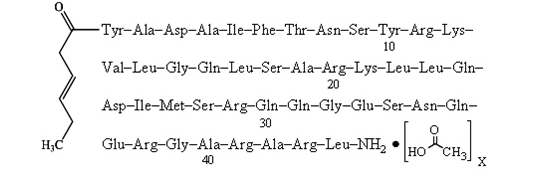
- Tesamorelin® is a sterile, white to off-white, preservative-free lyophilized powder for subcutaneous injection. After reconstitution with the supplied diluent (Sterile Water for Injection, USP), a solution of tesamorelin® is clear and colorless. Each single-use vial of tesamorelin® contains 2 mg of tesamorelin as the free base (2.2 mg tesamorelin acetate, anhydrous) and the following inactive ingredient: 100 mg mannitol, US
Pharmacodynamics
Effects on IGF-1 and IGFBP-3 levels
- Tesamorelin stimulates growth hormone secretion, and subsequently increases IGF-1 and IGFBP-3 levels.
Other Pituitary Hormones
- No clinically significant changes in the levels of other pituitary hormones, including thyroid-stimulating hormone (TSH), luteinizing hormone (LH), adrenocorticotropic hormone (ACTH) and prolactin, were observed in subjects receiving tesamorelin® in Phase 3 clinical trials.
Pharmacokinetics
Absorption
- The absolute bioavailability of tesamorelin® after subcutaneous administration of a 2 mg dose was determined to be less than 4% in healthy adult subjects. Single and multiple dose pharmacokinetics of tesamorelin® have been characterized in healthy subjects and HIV-infected patients without lipodystrophy following 2 mg subcutaneous administration.
- The mean values [coefficient of variation (CV)] of the extent of absorption (AUC) for tesamorelin were 634.6 (72.4) and 852.8 (91.9) pg.h/mL in healthy subjects and HIV-infected patients, respectively, after a single subcutaneous administration of a 2 mg tesamorelin® dose. The mean (CV) peak tesamorelin concentration (Cmax) values were 2874.6 (43.9) pg/mL in healthy subjects and 2822.3 (48.9) pg/mL in HIV-infected patients. The median peak plasma tesamorelin concentration (Tmax) was 0.15 h in both populations.
Distribution
- The mean volume of distribution (±SD) of tesamorelin following a single subcutaneous administration was 9.4±3.1 L/kg in healthy subjects and 10.5±6.1 L/kg in HIV-infected patients.
Metabolism
- No formal metabolism studies have been performed in humans.
Elimination
- Mean elimination half-life (T1/2) of tesamorelin was 26 and 38 minutes in healthy subjects and HIV-infected patients, respectively, after subcutaneous administration for 14 consecutive days.
Drug Interactions
Simvastatin
- The effect of multiple dose administration of tesamorelin® (2 mg) on the pharmacokinetics of simvastatin and simvastatin acid was evaluated in healthy subjects. Co-administration of tesamorelin® and simvastatin (a sensitive CYP3A substrate) resulted in 8% decrease in extent of absorption (AUCinf) and 5% increase in rate of absorption (Cmax) of simvastatin. For simvastatin acid there was a 15% decrease in AUCinf and 1% decrease in Cmax.
Ritonavir
- The effect of multiple dose administration of tesamorelin® (2 mg) on the pharmacokinetics of ritonavir was evaluated in healthy subjects. Co-administration of tesamorelin® with ritonavir resulted in 9% decrease in AUCinf and 11% decrease in Cmax of ritonavir.
Specific Populations
- Pharmacokinetics of tesamorelin in patients with renal or hepatic impairment, in pediatric patients, or in elderly patients has not been established.
Nonclinical Toxicology
Carcinogenesis, Mutagenesis, Impairment of Fertility
- Life-time carcinogenicity studies in rodents have not been conducted with tesamorelin acetate. No potential mutagenicity of tesamorelin acetate was revealed in a battery of tests including induction of gene mutations in bacteria (the Ames test), gene mutations in mammalian cells grown in vitro (hamster CHOK1 cells), and chromosomal damage in intact animals (bone marrow cells in mice). There was no effect on fertility in male or female rats following administration of tesamorelin acetate at doses up to 0.6 mg/kg (approximately equal to clinical exposure) for 28 days in males or 14 days in females. In the 26-week toxicity study in rats, females given approximately 16 and 25 times the clinical dose were more likely to be in diestrus.
Clinical Studies
- Two multicenter, randomized, double-blind, placebo-controlled studies were conducted in HIV-infected patients with lipodystrophy and excess abdominal fat (abdominal lipohypertrophy). Both studies (Study 1 and 2) consisted of a 26-week Main Phase and a 26-week Extension Phase. Main inclusion criteria were age 18-65 years, a waist circumference ≥95 cm (37.4 inches) and a waist-to-hip ratio ≥0.94 for men and ≥94 cm (37.0 inches) and ≥0.88 for women, respectively, and fasting blood glucose (FBG) <150 mg/dL (8.33 mmol/L). Main exclusion criteria included BMI ≤ 20 kg/m2, type 1 diabetes, type 2 diabetes, if previously treated with insulin or with oral hypoglycemic or insulin-sensitizing agents, history of malignancy, and hypopituitarism. Patients were on a stable anti-retroviral regimen for at least 8 weeks prior to randomization. Patients meeting the inclusion/exclusion criteria were randomized in a 2:1 ratio to receive 2 mg tesamorelin® or placebo subcutaneously daily for 26 weeks. The primary efficacy assessment for each of these studies was the percent change from baseline to Week 26 (Main Phase) in visceral adipose tissue (VAT), as assessed by computed tomography (CT) scan at L4-L5 vertebral level. Secondary endpoints included changes from baseline in patient-reported outcomes related to body image, triglycerides, ratio of total cholesterol to HDL cholesterol, IGF-1 levels, and safety parameters. Other endpoints included changes from baseline in waist circumference, abdominal subcutaneous tissue (SAT), trunk fat, and lean body mass. In both studies, tesamorelin®-treated patients completing the 26-week treatment period were re-randomized to blinded therapy with either daily placebo or 2 mg tesamorelin® for an additional 26-week treatment period (Extension Phase) in order to assess maintenance of VAT reduction and to gather long-term safety data. For inclusion in the Extension Phase studies, subjects must have completed the Main Phase with FBG ≤ 150 mg/dL.
Main Phase (Baseline to Week 26):
Study 1
- This study randomized 412 HIV-infected patients with lipodystrophy and excess abdominal fat to receive either tesamorelin® (N=273) or placebo (N=137). At baseline for the two groups combined, mean age was 48 years; 86% were male; 75% were white, 14% were Black/African American, and 8% were Hispanic; mean weight was 90 kg; mean BMI was 29 kg/m2; mean waist circumference was 104 cm; mean hip circumference was 100 cm; mean VAT was 176 cm2; mean CD4 cell count was 606 cells/mm3; 69% had undetectable viral load (<50 copies/mL); and 33.7% randomized to tesamorelin® and 36.6% randomized to placebo had impaired glucose tolerance, while 5.6% randomized to tesamorelin® and 6.7% randomized to placebo had diet-controlled diabetes mellitus. The twenty-six week completion rate in Study 1 was 80%.
Study 2
- This study randomized 404 HIV-infected patients with lipodystrophy and excess abdominal fat to receive either tesamorelin® (N=270) or placebo (N=126). At baseline for the two groups combined, mean age was 48 years; 84% were male; 77% were white, 12% were Black/African American, and 9% were Hispanic; mean weight was 88 kg; mean BMI was 29 kg/m2; mean waist circumference was 105 cm; mean hip circumference was 100 cm; mean VAT was 189 cm2; mean CD4 cell count was 592 cells/mm3; 83% had undetectable viral load (<50 copies/mL); and 44.1% randomized to tesamorelin® and 39.7% randomized to placebo had impaired glucose tolerance, while 9.3% randomized to tesamorelin® and 9.5% randomized to placebo had diet-controlled diabetes mellitus. The twenty-six week completion rate in Study 2 was 74%.
- Results for the Main Phases of Studies 1 and 2 are presented in Tables 3 and 4.
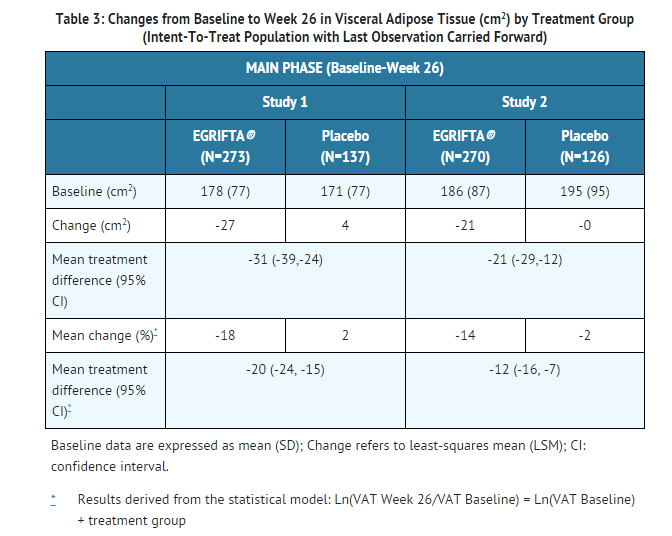
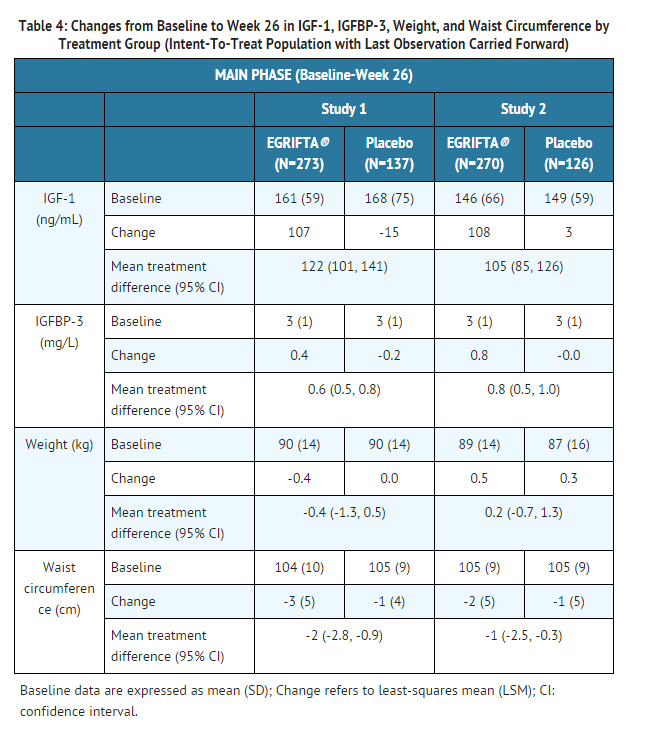
- A subgroup analysis by gender showed that there were no statistical differences in the percent change from baseline in visceral adipose tissue (VAT) and IGF-1 responses, respectively, between males and females.
- At Week 26, treatment with tesamorelin® resulted in a reduction from baseline in mean trunk fat of 1.0 kg in Study 1 and 0.8 kg in Study 2, respectively (compared with an increase of 0.4 kg in Study 1 and of 0.2 kg in Study 2, respectively, in patients receiving placebo). Treatment with tesamorelin® resulted in an increase from baseline in mean lean body mass of 1.3 kg in Study 1 and of 1.2 kg in Study 2, respectively (compared with a decrease of 0.2 kg in Study 1 and of 0.03 kg in Study 2, respectively, in patients receiving placebo).
- On average, there were no adverse effects of tesamorelin® on lipids or subcutaneous adipose tissue (SAT). tesamorelin® did not adversely alter antiretroviral effectiveness, such as mean circulating levels of CD4 counts or HIV-1 RNA (viral load).
Patient Reported Outcomes
- Patients rated the degree of distress associated with their belly appearance on a 9-point rating scale that was then transformed to a score from 0 (extremely upsetting and distressing) to 100 (extremely encouraging). A score of 50 indicated neutral (no feeling either way). A positive change from baseline score indicated improvement, i.e., less distress.
- The cumulative distribution of response (change from baseline to 26 weeks) is shown in Figure 1 for both treatment groups. A curve shifted to the right on this scale indicates a greater percentage of patients reporting improvement.
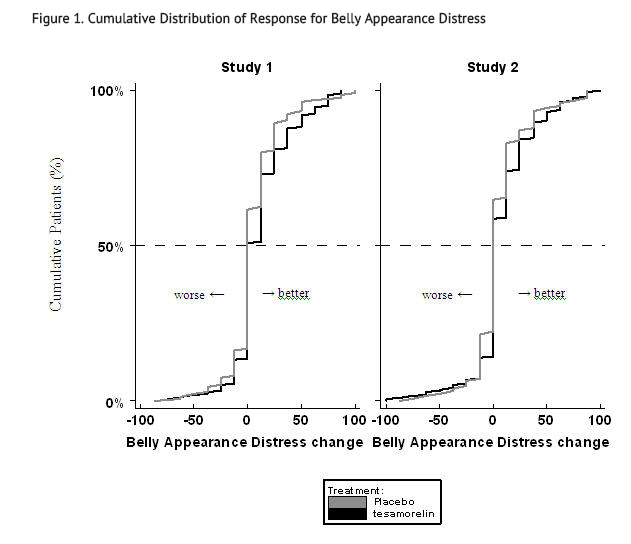
Extension Phase (Weeks 26-52):
- In the double-blind Extension Phase, patients on tesamorelin® completing the 26-week Main Phase were re-randomized to receive 2 mg tesamorelin® or placebo.
Study 1
- This study re-randomized 207 HIV-infected patients with lipodystrophy who completed tesamorelin® treatment in the Main Phase to receive either tesamorelin® (N=154) or placebo (N=50) for an additional 26-week duration (3:1 randomization ratio). At baseline (Week 26) for the two groups combined, mean age was 48 years; 88% were male; 78% were white, 12% were Black/African American, and 8% were Hispanic; mean weight was 90 kg; mean BMI was 29 kg/m2; mean waist circumference was 102 cm; mean hip circumference was 100 cm; mean VAT was 145 cm2; mean CD4 cell count was 639 cells/mm3; 68% had undetectable viral load (<50 copies/mL); and for those tesamorelin®-treated patients completing the 26-week treatment period that were re-randomized to tesamorelin® (T-T group) or re-randomized to placebo, 36.6% and 32.0%, respectively, had impaired glucose tolerance, while 2.0% re-randomized to tesamorelin® and 6.0% re-randomized to placebo had diet-controlled diabetes mellitus. The completion rate for patients randomized into the extension phase of Study 1 was 83%.
Study 2
- This study re-randomized 177 HIV-infected patients with lipodystrophy who completed tesamorelin® treatment in the Main Phase to receive either tesamorelin® (N=92) or placebo (N=85) for an additional 26-week duration (1:1 randomization ratio). At baseline (Week 26) for the two groups combined, mean age was 48 years; 90% were male; 84% were white, 9% were Black/African American, and 7% were Hispanic; mean weight was 89 kg; mean BMI was 28 kg/m2; mean waist circumference was 105 cm; mean hip circumference was 100 cm; mean VAT was 172 cm2; mean CD4 cell count was 579 cells/mm3; 82% had undetectable viral load (<50 copies/mL); and for those tesamorelin®-treated patients completing the 26-week treatment period that were re-randomized to tesamorelin® (T-T group) or re-randomized to placebo, 48.9% and 50.6%, respectively, had impaired glucose tolerance, while 4.3% re-randomized to tesamorelin® and 12.9% re-randomized to placebo had diet-controlled diabetes mellitus. The completion rate for patients randomized into the extension phase of Study 2 was 81%.
- Results for the Extension Phases of Studies 1 and 2 are presented in Tables 5 and 6.
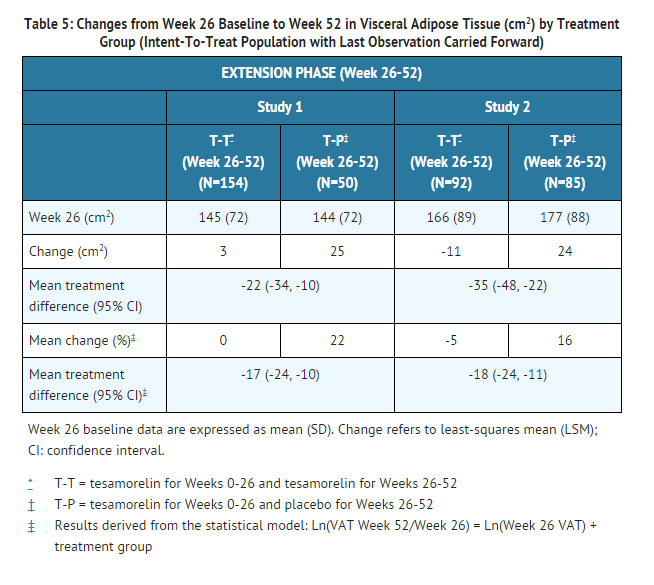
- Figure 2. shows the percent change in VAT from baseline (Week 0) over time until 52 weeks in completer patients.
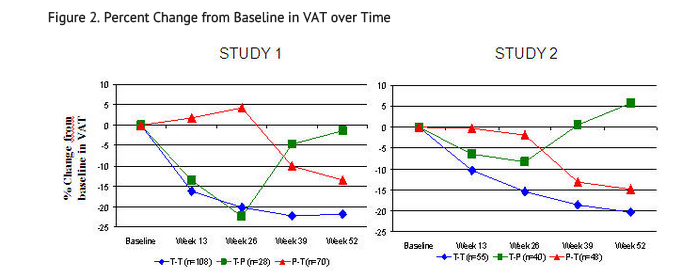
- Data in Figure 2 are expressed as mean values. T-T (tesamorelin to tesamorelin) refers to the group of patients who received tesamorelin for Weeks 0-26 and were re-randomized to tesamorelin for Weeks 26-52. T-P (tesamorelin to placebo) refers to the group of patients who received tesamorelin for Weeks 0-26 and were re-randomized to placebo for Weeks 26-52. P-T (placebo to tesamorelin) refers to the group of patients who received placebo for Weeks 0-26 and were switched to tesamorelin (treated open label) for Weeks 26-52.
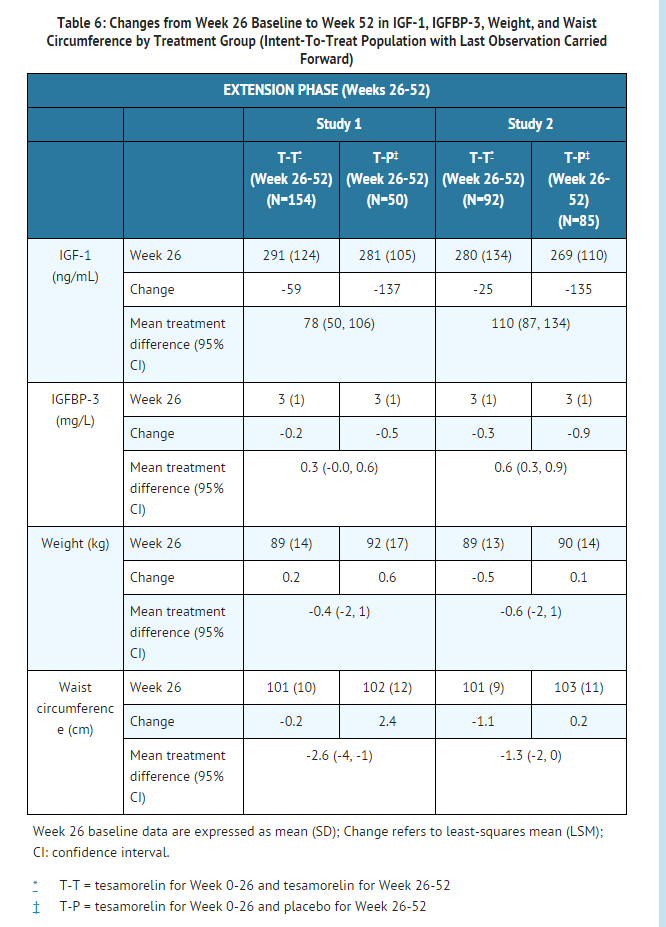
- Patients treated with tesamorelin® for 52 weeks (T-T group) showed no change between Weeks 26 and 52 in mean trunk fat (increase of 0.1 kg in Study 1 and decrease of 0.5 kg in Study 2, respectively, compared with an increase of 1.4 kg in patients in the T-P group in Study 1 and an increase of 1.09 kg in Study 2, respectively) nor was there a change from Week 26 baseline in mean lean body mass (decrease of 0.1 kg in Study 1 and increase of 0.1 kg in Study 2, respectively, compared with a decrease of 1.8 kg in patients in the T-P group in Study 1 and a decrease of 1.7 kg in Study 2, respectively).
- There was no adverse effect of tesamorelin® on lipids or subcutaneous adipose tissue (SAT). tesamorelin® did not adversely alter antiretroviral effectiveness, such as mean circulating levels of CD4 counts or HIV-1 RNA (viral load).
How Supplied
- Tesamorelin (tesamorelin for injection) is supplied as a sterile, white to off-white lyophilized powder. Each single-use vial of tesamorelin® contains 2 mg of tesamorelin as the free base (2.2 mg tesamorelin acetate, anhydrous) and the following inactive ingredient: 100 mg mannitol, USP.
- tesamorelin® is available in a package comprised of two boxes. One box contains 30 vials of tesamorelin® and a second box contains 30 single-use 10 mL bottles of reconstitution diluent (Sterile Water for Injection, USP), disposable syringes, and needles sufficient for a 30 day supply.
- After reconstitution with Sterile Water for Injection, USP the reconstituted solution concentration is 1 mg/mL and should be injected immediately.
Storage
- Tesamorelin vials should be protected from light and be kept in the original box until time of use. Non-reconstituted tesamorelin® must be stored at refrigerated temperature, between 2°C and 8°C (36°F and 46°F) until dispensed. Upon dispensing, the patient may store non-reconstituted tesamorelin® at refrigerated temperature until the expiration date, or at or below 25°C (77°F) for 3 months or until the expiration date, whichever occurs first. The reconstitution diluent (Sterile Water for Injection, USP), syringes and needles should be stored at controlled room temperature of 20ºC to 25ºC (68°F to 77°F).
Images
Drug Images
{{#ask: Page Name::Tesamorelin |?Pill Name |?Drug Name |?Pill Ingred |?Pill Imprint |?Pill Dosage |?Pill Color |?Pill Shape |?Pill Size (mm) |?Pill Scoring |?NDC |?Drug Author |format=template |template=DrugPageImages |mainlabel=- |sort=Pill Name }}
Package and Label Display Panel




{{#ask: Label Page::Tesamorelin |?Label Name |format=template |template=DrugLabelImages |mainlabel=- |sort=Label Page }}
Patient Counseling Information
- Fluid retention – Advise patients that treatment with tesamorelin may cause symptoms consistent with fluid retention, including edema, arthralgia, and carpal tunnel syndrome. These reactions are either transient or resolve with discontinuation of treatment.
- Hypersensitivity Reactions – Advise patients that hypersensitivity reactions (e.g., rash, urticaria) may occur during treatment with tesamorelin®. Advise patients to seek prompt medical attention and to immediately discontinue treatment with tesamorelin®.
Injection Site Reactions – Advise patients of possible injection site reactions, including injection site erythema, pruritus, pain, irritation, and bruising. To reduce the incidence of injection site reactions, advise patients to rotate the site of injection.
- Counsel patients that they should never share an tesamorelin® syringe with another person, even if the needle is changed. Sharing of syringes or needles between patients may pose a risk of transmission of infection.
Pregnancy
- Advise women to discontinue tesamorelin® if pregnancy occurs, as the drug offers no known benefit to pregnant women and could result in fetal harm.
Nursing Mothers
- Because of both the potential for HIV-1 infection transmission and serious adverse reactions in nursing infants, mothers receiving tesamorelin® should be instructed not to human milk-feed
Precautions with Alcohol
- Alcohol-Tesamorelin interaction has not been established. Talk to your doctor about the effects of taking alcohol with this medication.
Brand Names
- Tesamorelin
Look-Alike Drug Names
Drug Shortage Status
Price
References
The contents of this FDA label are provided by the National Library of Medicine.
{{#subobject:
|Page Name=Tesamorelin
|Pill Name=No image.jpg
|Drug Name=
|Pill Ingred=|+sep=;
|Pill Imprint=
|Pill Dosage={{{dosageValue}}} {{{dosageUnit}}}
|Pill Color=|+sep=;
|Pill Shape=
|Pill Size (mm)=
|Pill Scoring=
|Pill Image=
|Drug Author=
|NDC=
}}
{{#subobject:
|Label Page=Tesamorelin |Label Name=Tesamorelin package insert.png
}}
{{#subobject:
|Label Page=Tesamorelin |Label Name=Tesamorelin pt information.png
}}
{{#subobject:
|Label Page=Tesamorelin |Label Name=Tesomorelin image.jpg
}}
{{#subobject:
|Label Page=Tesamorelin |Label Name=Tesomorelin ingredients and appearance.png
}}